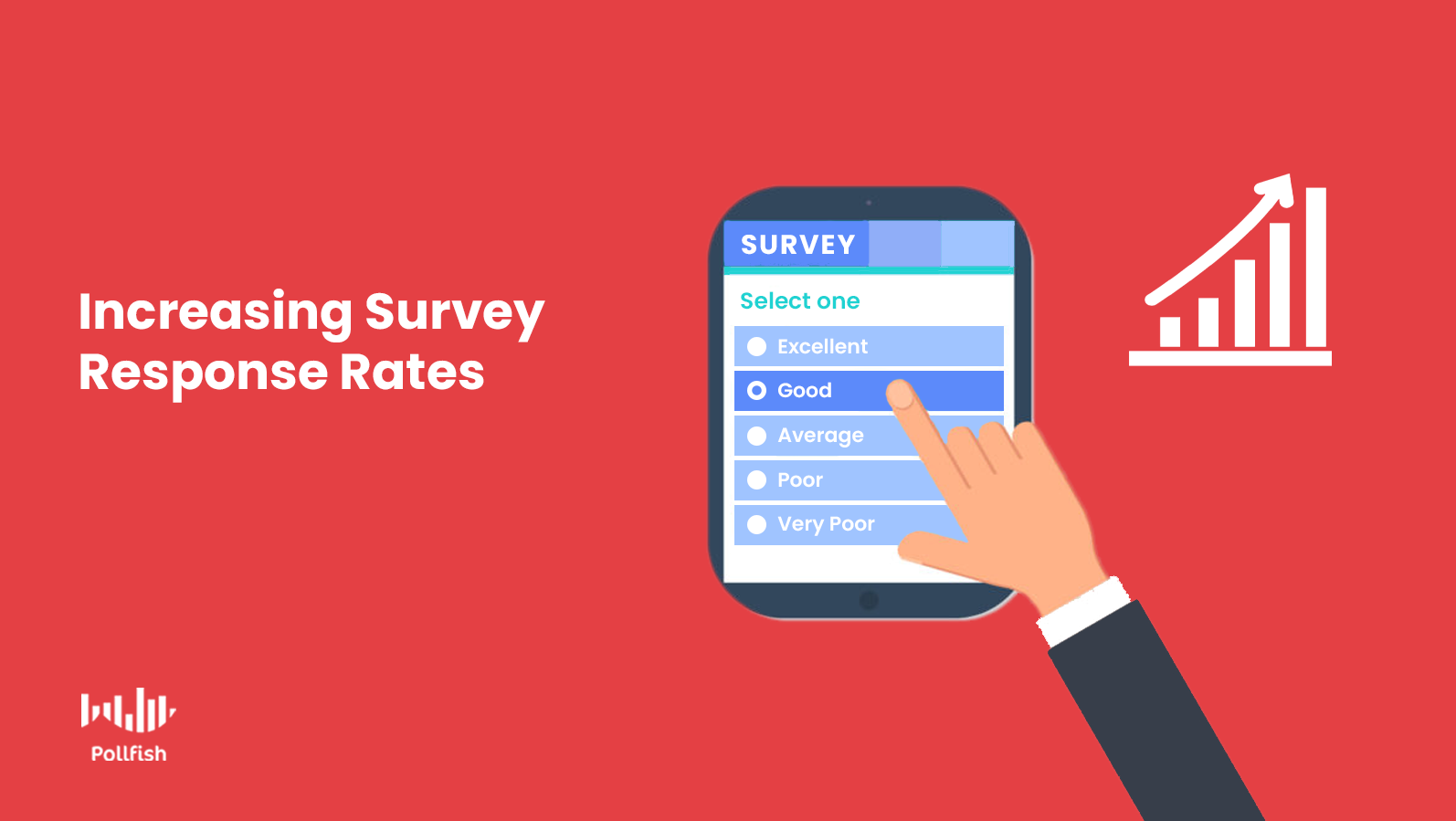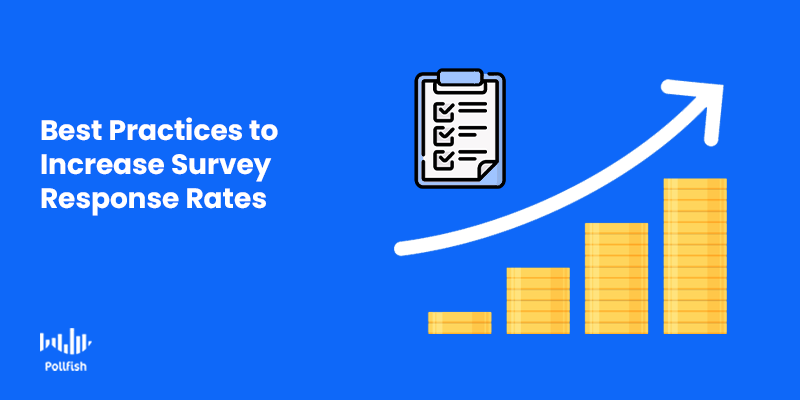How to Increase Survey Response Rates

Marketers and market researchers ought to keep a watchful eye on their survey response rates. These indicate the percentage of online users who have seen and completed a survey.
If you’ve launched a survey and nobody responded to it, then have you launched one at all? Or, perhaps you’ve set one in motion, but unfortunately, it received low response rates. These are the realities market researchers face when running surveys in the wild jungle known as the Internet.
As crucial as it is to form a thorough and well-rounded survey, it is equally important that it receives the intended amount of responses. Moreover, it is crucial that these responses come from your target market and all those you target in your market research campaign.
This article covers survey response rates so that your research receives the proper amount, allowing you to draw statistical and qualitative conclusions key to help your business scale.
Defining Survey Response Rates
Survey response rates identify how many of your respondents completed their surveys. These can change from campaign to campaign and from one survey launch to the next. In any case, they all point to a specific metric that illustrates the success of your survey participation.
There are two types of survey response rates. Both use the same formula but with slightly different variables. They include the following:
The first method involves measuring the percentage of respondents who completed their survey in comparison to the number of those who viewed or started the survey. These survey response rates calculate how successful your surveys were in engaging their target audience. This method is apt for market researchers who distribute their surveys to a preset sampling pool size (usually online).
Survey response rates can also be generated by comparing survey completes to the total sampling group. This approach is used when market researchers invite specific people (as opposed to all who fit their target survey audience) to take a survey. For example, some researchers may personally reach out to their sampling pool via email, text message, social media or even a phone call to request their survey participation.
How to Calculate Survey Response Rates
As aforementioned, both approaches to discovering survey response rates use the same formula, with only mildly differing variables. The formula provides a quick and practical way to calculate survey response rates.
Use the following formulas for the two approaches:
- For the First Approach:
- Divide the number of completed responses by the number of people who either viewed or started the survey. Then multiply the quotient (the result of the division by 100).
- For example: if 300 people viewed your survey, while 170 people completed it, the calculation would be derived as follows: 170/300 = 0.566 0.566 x 100 = 56.6%
- 56.6% = the response rate
- For the Second Approach:
- Divide the number of respondents who completed the survey by those who have been invited to take part in the survey. Multiple the quotient by 100 to get the percentage.
- For example: If 400 people were invited to take the survey and 190 of them completed it, the calculation for the rate would be: 190/400 = 0.475 0.475 x 100 = 47.5%
- 47.5% = the response rate
Standard Survey Response Rates & Which to Aim For
When you endeavor to find your survey response rates, it is key to have a reference point of comparison. This way, you’ll understand how your rates measure up with standard industry rates. Additionally, comparing your response rates with benchmark rates will help you determine if they can be categorized as good or bad.
Most online survey platforms report average survey responses well below 50%. For example, PeoplePulse found that the median survey response rate of online surveys is 26.45%, while the average rate for surveys with under 1,000 participants is 41.21%. Genroe reported that a good rate is any above 25%.
This makes sense, given that most organizations report external surveys hovering around the 20% mark. Internal surveys, such as an employee satisfaction survey, generate higher survey response rates, typically between 30-40%. This is unsurprising, given that employers urge their workers to complete these surveys — and workers take heed.
Businesses and research organizations should aim for response rates that surpass 25%. Since large invitation lists are associated with lower survey response rates, it is key to keep these lists on the shorter end of the scale, with the possibility of iterating the surveys in one campaign.
The Consequences of Low Survey Response Rates
Low survey response rates have a number of consequences that businesses and research organizations ought to steer clear of. Here are a few of the negative results these rates can incur:
- Inconclusive results: When too few people take part in a survey, the results do not bear statistical relevance. This means you cannot use them for quantitative studies, which make up a large bulk of survey research. Low response rates may reap critical qualitative studies, but, when the rates are too low, the research cannot be considered conclusive.
- Uninterested survey pool: Low rates point to an uninterested group of survey respondents. This is worrisome as it requires changing minds so that would-be respondents do an about-face and complete the survey. Additionally, it is troubling as this group can be all the contacts businesses possess in an email list.

- High error levels: Surveys with low response rates fall victim to a higher margin of error. This critically undermines the accuracy of the surveys’ findings. An unfathomably high rate of 100% bears the industry brunt of a 5% margin of error. As such, this error is far higher among lower response rates, especially those that barely hit the one-third mark.
- Nonresponse bias: Low response rates often signify nonresponse bias, which takes precedence when one or more demographics in your study don’t complete a survey. This bias creeps up in a number of settings: it can be due to a lack of interest in the survey topic, your email being labeled a scam, or if you send the survey at an inappropriate time (think religious holidays)
- Repackaging of surveys: Oftentimes, to remedy low response rates, researchers have to return to already launched surveys and reiterate the survey campaign. While this can generate more results, including surveys with higher response rates, it takes more time and effort, which instead could have been spent on other survey campaigns or on the analysis portion of a survey study.
How to Increase Survey Response Rates

Now that we’ve covered the various crucial aspects of survey response rates, it is time to adopt certain best practices to preempt low survey response rates or increase low rates if you already have them. Here are a few methods to increase response rates so that you collect as much data as necessary.
- Shorten your surveys: No one wants to spend a significant portion of their precious time filling out surveys. As such, keep surveys, short, sweet and to the point. As such, create surveys that take no longer than 5 minutes to complete. A good rule of thumb is to keep questions at 12 and under. If, however, your survey research requires more questions, consider breaking up one survey into several.
- Add incentives: Survey incentives motivate people to take surveys, as they’ll be rewarded for their time. No one likes to do anything for free, especially the demographics that are known for being time-poor (parents, workers of more than 1 job, etc.). Researchers can get creative with their incentive offerings, as these do not necessarily have to be cash.
- Implement engaging elements: A plain survey design with text only won’t trigger anyone to take your survey. Instead, consider creating a more lively survey with less text and more visual elements such as images, short videos and GIFs. You should also expand on the types of questions you ask. For example, avoid consecutive matrix-scale or Likert-scale questions.
- Create an enticing call to action: Also known as call-outs in the context of surveys, these elements are what triggers people to take a survey (if you’re sending them via an online survey tool). These are often short and are located on a button or element which opens up or transports users to your survey. If you offer an incentive, it’s key to mention it upfront, aka, in the call-out.
- Offer the surveys across channels: Don’t settle for one website, no matter how popular it is, to dispense your survey. Instead, distribute your survey across various websites and on mobile apps, as we are living in a mobile-first world, after all. It is unlikely that your target market frequents just one digital property.
Avoiding Survey Response Rates Altogether
Your survey response rates shed light on your surveys’ performance. As such, it is crucial to maintain healthy rates — otherwise, you’re unintentionally miring your own survey data. This data is already subject to a margin of error, even with high response rates.
Since surveys are the most potent forms of primary research, it is best to avoid faulty surveys. There is one surefire way to avoid faulty surveys: by avoiding survey response rates altogether.
Does this sound impossible? It isn’t with the correct online survey tool in place. Survey software, as alluded to in the first approach, allows you to preset the exact amount of responses your survey requires, including quotas for particular respondents. These settings ensure that you only gather the responses from participants you target. It also means that the survey tool does all the heavy lifting — meaning that you don’t need to check your survey response rates, as the tool is going to run surveys until the set amount of survey completes is reached. Thereby, you avoid the need to check and stress over your survey response rates.
Frequently asked questions
What are survey response rates?
Survey response rates — not to be confused with the survey completion rate — refer to two methods that calculate the percentage of people who completed a given survey.
How are survey response rates calculated?
There are two types of survey response rates. In the first type, the percentage is calculated by comparing the total number of people who completed the survey with the total number who viewed or started the survey. In the second type, the percentage is calculated by comparing the total number of completed surveys with the total number of individuals who were invited to take the survey.
What is the average response rate for online surveys?
For most online surveys, the response rate is typically below 50%.
What is considered a good response rate for online surveys?
A good rate for external surveys is anything above 25%. For internal surveys, such as employee satisfaction surveys, a good rate is anything about 30%.
What are some of the consequences of low survey response rates?
If a survey has a low response rate, the survey is more likely to yield inconclusive results, have higher error levels, and suffer from nonresponse bias.
What are some tactics to improve survey response rates?
Some of the ways to improve survey response rates include: shorten the length of the survey, add an incentive for completing the survey, improve the format of the survey so it is more engaging, and ensure the survey is distributed across a variety of channels.
Pollfish Marketing Team
Ready to Try Pollfish?
Create your survey with AI, target high-quality respondents starting at $0.95 per complete, and start getting results in just minutes in real-time. From running a simple product concept survey to managing a constant stream of trackers for dozens of clients in dozens of countries, we’ve got you.

